This site is made possible by its sponsors.
Please visit them!
E.A. - The abbreviation for the French term épreuve d'artiste, meaning artist's proof.

ear - In casting, a depression that receives a pin for aligning the pieces in a two-piece mold. Pictured here is a two-piece rubber mold in which a jeweler can cast a wax ring to be used in lost-wax casting. An ear can be seen at each corner of the right half of the mold.
Also see concave, dent, mortise, register and register mark.
![]()
earth colors - Pigments, such as yellow ochre and umber, that are obtained by mining; usually metal oxides.
Also see color, color wheel, and warm colors.
earthworks - See earth art.
ecce homo - The title commonly given to depictions of Christ as he was presented to the crowd for crucifixion. Latin for "Behold, the man." The story of Pontius Pilate is told in various books of the Bible. The 'Ecce homo' episode is from John 19:5. Matthew 27:24. "When Pilate saw that he was doing no good, indeed that a riot was impending, he took some water, washed his hands before the crowd and said, "I am innocent of this man's blood. It is your affair."
(pr. ET-chay HOH-moh)
Examples of works titled Ecce Homo:
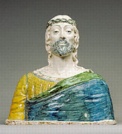
Unknown Italian, Ecce Homo, Faenza or Florence, about
1500, tin-glazed earthenware,
height 23 3/4 inches (60.3
cm), J. Paul Getty Museum, Malibu, CA. See bust.

Simon Bening (Flemish, Bruges, 16th century), Ecce Homo, about 1525-1530, tempera colors, gold paint, gold leaf, and ink on parchment,
6 5/8 x 4 1/2 inches, Getty Museum, Malibu, CA.

Lovis Corinth (German, 1858-1925), Ecce Homo, 1925, oil
on canvas, 190.5 x 150 cm,
Kunstmuseum, Basel, Switzerland. See secession.
Also see crucifix.
eccentric - Literally, not having the same center, and figuratively, departing from the typical or established norm or pattern, heterodox. A person who deviates markedly from an established norm, especially one exhibiting odd or unconventional behavior — off-center. It can also be used to describe something that doesn't follow a truly circular path, as in "an eccentric orbit." "Eccentric" contrasts with "concentric": having a common center; concentric circles are placed one within another.
Two Venn diagrams present examples of sets of eccentric shapes:

The three eccentric circles in this example are equal in size. Although they do not share the same centers, their centers are equidistant from each other. See analogous colors, equilateral, overlap, translucent, and triangle.
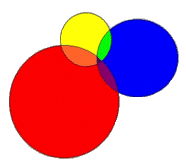
The three eccentric circles in the second example are of different sizes, their centers placed at varying distances from each other. These circles are more irregularly eccentric than the first three. See primary and secondary colors.
Quote:
Also see academic, avant-garde, bias, bohemianism, centering, center of gravity, different, and transgressive.
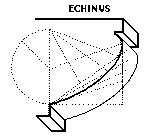
echinus - In architecture, the convex element of a capital directly below the abacus.
(pr. ə-KI:-nəs)
eclecticism - A system or method in which individual elements are selected or employed from a variety of sources, systems, or styles.
Also see gemütlichkeit, multiculturalism, pastiche, and thematic.
écorché - A figure drawn, painted, or sculpted to show the muscles of the body without skin. The Renaissance architect and theorist, Leon Battista Alberti (Italian, 1404-1472), recommended that when a painter is going to depict a nude, he should first arrange the muscles and bones, then pick out a nice skin to go with them.
(pr. ay-KOHR-shay)
Examples:

Nicolas Beatrizet, Anatomia, from Juan de Valverde de Hamusco's
'La anatomia del corpo humano', 1556. This man has flayed
himself, and is holding up his own skin.

Jean-Antoine Houdon (French, 1741-1828),
L'Écorché
(Flayed Man, Standing), 1767,
plaster cast taken from the original
écorché (in marble?)
Such life-size sculptures of a flayed man have served
as models for art students
studying human anatomy, in
preparation for life drawing.
Students' uses of such figures
has diminished greatly since the end of the nineteenth century.
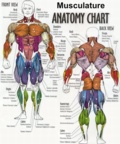
American, Anatomy Chart of Musculature, late twentieth
century. This diagram was
apparently designed for body-builders. Aside from muscles in
the head, hands, and feet, those in all of the major muscle groups
are color coded and named.
Also see bone structure and academy figure.
edakumi-ryo - In Japanese art tradition, Bureau of Painters.
Also see edokoro.
edge - Where two things meet. Also, edge may refer to a quality sensed in artworks which is other than a smooth decorativeness; and that may be a sense of something unusual, disturbing, controversial, or in any of many other ways more demanding of the audience.
Also see aliased and anti-aliased, ancipital, align and alignment, avant-garde, banausic, bland, butt, definition, dissonance, feather, French curve, frisson, grotesque, heterodox, incongruity, interesting, juxtaposition, margin, marginalia, perpendicular, signature, straight, tangent, tension, theater, and transgressive.
edition - A set of identical prints, sometimes numbered and signed, pulled by, or under the supervision of the artist. Two numbers are often written at the lower edge of a print — the first indicating the print's place in the order of all prints in the edition, the second number indicating the total number of prints in the edition.
Example:

Jacques Lipchitz (Lithuanian born, became
a French citizen 1925, an American citizen 1958, 1891-1973),
Bellerophon Taming Pegasus: Large Version,
1964-66, bronze,
edition 1/2 — the first of two
cast, 179 1/2 x 134 x 59
inches, Kemper Museum of Contemporary Art, Kansas City, MO.
Also see artist's proof, limited edition and posthumous.
edokoro - In Japanese tradition, Bureau of Painters.
Also see edakumi-ryo and Japanese art.
effigy - A likeness or image, especially of a person. A likeness of a deceased person, when placed on his tomb, is usually called an effigy. Now, more often a crude figure or dummy of someone despised; a symbolic image of a person. Perhaps this latter sense arises from a wish that the subject were dead.
Examples:
Central America, Costa Rica, Guanacaste-Nicoya, Rosales Zoned Engraved Female Effigy, Period IV, 300 BCE - 300 CE, bichromatic ceramic, 12 3/4 x 9 1/4 inches (32.1 x 23.3 cm), Michael C. Carlos Museum, Emery U, Atlanta, GA. See Pre-Columbian art.
Zaïre, Mangbetu, Female Effigy Vessel, early 20th century, ceramic, 8 x 6 inches (20.2 x 15.1 cm), Michael C. Carlos Museum, Emery U, Atlanta, GA. See African art.

About 100,000 marchers gathered in 1996,
depicting Serbian President Slobodan Milosevic as a thief who
had stolen their votes and ignored their opinions.
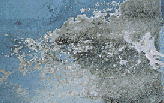
efflorescence - A formation of white crusty material — crystals resulting from penetration of moisture through painted walls — especially brick, tile, or uncoated plaster. It may also be produced by soluble material present in the wall itself.
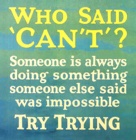 effort
- Mental or physical energy used to achieve a purpose; self-discipline.
A person's exertions to reach a particular goal
or overcome particular difficulty. At minimum, effort is attempting
to accomplish something. Sometimes an effort is remarkable because
it is something someone is trying to do for the first time.
effort
- Mental or physical energy used to achieve a purpose; self-discipline.
A person's exertions to reach a particular goal
or overcome particular difficulty. At minimum, effort is attempting
to accomplish something. Sometimes an effort is remarkable because
it is something someone is trying to do for the first time.
In science, effort is synonymous with energy, and can be measured. In the arts, although effort — the exertion of energy — is essential, it is less tangible than the end result. The art world is typically interested in artists' intentions, but more so in artists' achievements. No collector acquires the "trying" unless it is palpable. When effort is particularly apparent, art critics and historians dwell on those exertions, and might speculate on them when they are not apparent. Although conceptual art might seem to be an exception to this rule, ultimately the quality of what any artist has done relies on that which can be seen in the work itself — its making, its production, its success.
|
Art educators might assess students' efforts as much as they do their achievements. Effort is more difficult to observe well enough to quantify it. Unless a student displays extraordinary challenges, basing an assessment on effort alone devalues and invalidates that assessment, and may be counterproductive and unethical. Pressure to assess the efforts of able students without assessing their achievements may come from students, their families, or other educators. Their arguments might be: Art disciplines are somehow different from other disciplines. Yes, the art disciplines are different in several important ways — ones that put the study of art at the heart of our students' education. Nearly every student who enrolls here and exerts energy can and should achieve great things. Not everyone does. But our expectations are not inappropriate — they're specific to what successful students should achieve. Some students have no interest in becoming artists. Art should primarily be uplifting / amusing / recreational / therapeutic. Art should be much more than entertainment. The best art has a habit of being the most interesting art. Even more important: art is basic. As we motivate students, simultaneously we pursue many other goals. Just look at our school's / state's / nation's fine arts standards. All of our students need to understand that they are expected to do their best, and that they are most likely to achieve to their potential when they give it their all -- when no one makes excuses for them. There are already so many things interfering with their learning! But talent isn't distributed equally, and some or all students are required to (or non-art-majors would like to) enroll in art. If this argument is valid, it could be made for students of any discipline! Every educator here works with every student he gets. (The "talented" ones are in there with everyone else. Or they just learn differently.) If you don't give higher grades, fewer students will enroll in art classes, and you won't have a job. When an educator inflates grades, respect for standards collapses as the program becomes a haven for non-achievers.
ArtPage would like to post your ideas here. Do you have suggestions? Email us. In the subject line, please type "article about effort." |
Quotes:
A joke:
A flood was threatening a town, forcing everyone to evacuate. But Joe was thinking, "I'm a devout man; God will save me," and he stays put. As the waters rise, Joe's neighbor comes by and says, "Joe, come with me. we've got to go." Joe declines: "I'm a devout man. God will save me." The waters keep rising. Joe scrambles to his second floor. A firefighter in a rowboat paddles by. "Get in the boat or you'll drown," he says. Joe again declines, saying, "I'm a devout man. God will save me." Finally, the flood waters force Joe to his roof. A police helicopter comes by and throws down a rope. "Climb up or you'll drown," the policeman yells. "No," Joe replies, "I'm a devout man. God will save me." But soon Joe drowns. When he arrives in heaven, Joe challenged God, "Why didn't You help me?" "What do you mean?" God says. "I did help. I sent a neighbor, a firefighter, and a helicopter."
Also see achievement, advocacy, artistic temperament, art therapy, attention, attitude, creativity, empathy, enthusiasm, evaluation, genius, Individualized Education Program (IEP), inspiration, multiple intelligence theory, obsession, praise, research, and talent.
 egg-and-dart
- A decorative pattern commonly used in molding
on architecture or furniture, in which a series of oval
figures alternate with
arrowhead figures of various types — sometimes described
as anchors, tongues, or slightly tapered bars. It is found in
classical Greek and Roman
architecture, as well as in styles
derivative of them, including beaux-arts
classicism, classical revival, federal, Georgian revival, Greek
revival, Neoclassicism,
Renaissance revival, Second Empire.
egg-and-dart
- A decorative pattern commonly used in molding
on architecture or furniture, in which a series of oval
figures alternate with
arrowhead figures of various types — sometimes described
as anchors, tongues, or slightly tapered bars. It is found in
classical Greek and Roman
architecture, as well as in styles
derivative of them, including beaux-arts
classicism, classical revival, federal, Georgian revival, Greek
revival, Neoclassicism,
Renaissance revival, Second Empire.
Also see festoon, rhythm, and shape.
egg-oil emulsion - A painting medium.
egg tempera - A watercolor medium used for permanent, fine works.
Examples of works painted in egg tempera:

Andrew Wyeth (American, 1917-), Dodges Ridge, 1947, egg tempera on fiberboard,
41 x 48 inches (104.2 x 122.0 cm), National Museum of American
Art, Washington, D.C.
Jacob Lawrence (American, 1917-), The Library, 1960, tempera on fiberboard, 24 x 29 7/8 inches (61.0 x 75.9 cm), National Museum of American Art, Washington, DC. See Harlem Renaissance.
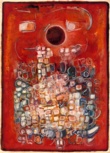
David C. Driskell (American, 1931-), Movement, The Mountain, 1980, egg tempera on canvas. See African American art.
Related resources:
Also see American Watercolor Society (AWS), distemper, paint, painting, and tempera.
Egyptian blue - A particular blue pigment.
Related resource:
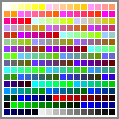
8-bit image - A digital
image, with eight bits allocated for the storage of each pixel, meaning 256 different
colors are possible. The 256 colors
can be seen in this color
look-up table (CLUT).
ekphrasis, ekphratic - Ekphrasis came from Greek (ek- = out, -phrasis = I explain); descriptive language so clear and vivid that it brings about visualization — seeing through hearing or reading. Ekphratic is the adjectival form.
Quote:
(pr. ək-FRAY-səs, ək-FRA-tək )
Elamite art - See Mesopotamian art.
electrolysis - Chemical change, especially decomposition, produced in an electrolyte, by an electric current.
Also see electroplate and electrotype.
electrolyte - A chemical compound that ionizes when dissolved or molten to produce an electrically conductive medium.
Also see electroplate.
electronic portfolio - A portfolio or set of images of work which is stored on a computer disc. The original work may have been created electronically or scanned from other media.
electroplate - To coat a metal — usually iron, nickel, or copper — with brass, chrome, copper, gold, silver, or another metal. This process is often simply called plating. The base metal is placed in a container of water in which it becomes an electrode, which is then gradually coated with particles of another metal by electrolysis.
electrotype - The reproduction of a model by coating a mold taken from it with metal (commonly copper) by electrolysis.
electrum - An alloy of gold and silver, pale yellow in color.
elegance - Refinement, grace, and beauty. Tasteful opulence in form, decoration, or presentation. Restraint and grace of style.
Example of a particularly elegant image:
An animated image of a tetrahedron. See polygon and tetrahedron.
Quote:
Also see abstraction, composition, horror vacui, ikebana, interdisciplinary, limitation, principles of design, simplicity, and sublime.
elements of art or elements of design - The basic components used by the artist when producing works of art. Those elements are color, value, line, shape, form, texture, and space. The elements of art are among the literal qualities found in any artwork.
Related links:
Also see principles of design.
elevation - In architecture and drawing, a scale drawing of the side, front or rear of a structure. A geometric projection of a building on a plane perpendicular to the horizontal; a vertical projection.
Examples:
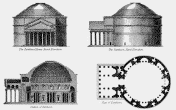
English, from the Encyclopedia Britannica,
1897: Four
views of the Roman Pantheon, 118 CE: front elevation, flank elevation,
cross-section, and floor plan, late 19th century, engraving. The
front elevation is the image on the upper-left. The flank or
side elevation is on the upper-right. See cross-section,
plan, and pantheon.
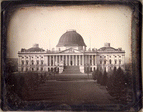
John Plumbe, Jr. (American, 1809-1857), United States Capitol, Washington, D.C.,
east front elevation, half-plate
daguerreotype,
c. 1846, Library of Congress, Washington, DC. One of the earliest
surviving photographs
of the Capitol, Plumbe's elevation shows the building with its
old copper-sheathed wooden dome.
Frank Lloyd Wright (American, 1869-1959), Two Elevation Drawings for Taliesin II, near Spring Green, Wisconsin, 1914, ink on linen. This drawing was done in conjunction with the first major rebuilding of Taliesin in 1914. Also see Aerial View for Taliesin II, 1914, ink on paper, and Plan for Taliesin III, c. 1925, ink, graphite, and colored pencil on tracing paper.
Also see cross-section and plan.
elitism and elitist - The belief that certain persons deserve favored treatment by virtue of their superior artistic or intellectual accomplishments, or because of some other real or perceived status. People and things reach various levels of achievement, of success, and for better or worse, people judge the qualities of other people and things. But elitism is a tendency to codify levels of artistic sophistication into a hierarchical system that some would call pretentiously exclusionary, and others realistic. Elitism is the sense of entitlement that follows from this attitude, and the control or dominance by a group of elitists — the people who take this view of their position. Elitism always elicits aesthetic questions about defining art, who is an authority about it, and what that means for people who aren't.
Elitism in the art world is the insistence that art is somehow out of the realm of common experience, that its pleasures are not available to everyone. It has become increasingly necessary to read texts (artists' statements, wall labels or plaques, articles of art criticism, etc.) in order to understand certain works of art, but this is what great contemporary art does: It advances through ideas, by engaging our minds. Art galleries, because their offerings are commodities, are invariably commercial enterprises, but they are among the only places where the public can see art free of charge. Museums serve comparable roles as a community's storehouse of art, exhibiting works to their vistors, educating visitors to the works' significance, garnering support in ways unlike the galleries'. Wherever encounters with art occur, they always demand the viewer's attention and receptivity. Failure to embrace those opportunities are at least, simply that: losses of opportunities, significant as those can be.
Quote:
See advocacy.
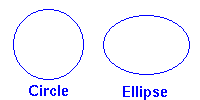 ellipse - A plane
curve, especially either a
conic section
whose plane is not parallel
to the axis, base, or generatrix
of the intersected cone, or the locus of points
for which the sum of the distances from each point to two fixed
points is equal. Note the similarity and difference between a
circle and an ellipse.
ellipse - A plane
curve, especially either a
conic section
whose plane is not parallel
to the axis, base, or generatrix
of the intersected cone, or the locus of points
for which the sum of the distances from each point to two fixed
points is equal. Note the similarity and difference between a
circle and an ellipse.
(pr. ə-LIPS)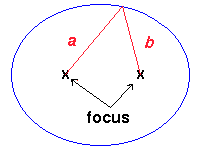
How to
draw an ellipse: Place a focus
in each of two locations by holding down the ends of a string
in two places (a + b). Place a
drawing tool against the string in
order to stretch it as the red line is in this diagram.
Draw the curve made by keeping the string taut ftom left to right
extremes both above and below the horizon made by a straight
line through a and b.
Related links:
Also see arc, cone, cylinder, ellipsis (from which ellipse is derived), hyperbola, oval, ovoid, parabola, shape, and sphere.
ellipsis - The omission of a word or phrase necessary for a complete syntactical construction but not necessary for understanding, or an example of such omission. Also, a mark or series of marks (typically: ...) used in writing or printing to indicate an omission, especially of letters or words. (pr. e-lip'ses) The plural form is ellipses.
(pr. ə-LIP-seez)
Also see closure, ellipse, erasure, gestalt, lacuna, shard, space, and void.
elongate - Stretching an object or figure lengthwise, thus altering its proportion and making it look taller and more slender; a type of distortion often interpreted as stylization.
Examples:
![]()
Jacopo Carrucci da Pontormo (Italian, Florence,
1494-1557), Halberdier (Francesco Guardi?), about
1528 - 1530, oil (or oil and
tempera) on panel transferred to
canvas, 36 1/4 x 28 3/8 inches
(92 x 72 cm), J. Paul Getty Museum, Malibu, CA.
El Greco (born Doménikos Theotokópoulos) (Spanish, born Crete, 1541-1614), Christ on the Cross Adored by Donors, c. 1585-1590, oil on canvas, 2.60 x 1.781 m, Louvre. See Mannerism.

![]()
![]()
Amedeo Modigliani (Italian, 1884-1920), Head, c. 1911-2, limestone,
63.5 x 12.5 x 35.0 cm, Tate Gallery, London. Another view. This elongated head was inspired
by African
masks and Gothic sculptures.
Also see anamorphosis.
ema - In Japanese art tradition, a votive painting.
e-mail - Computer-based personal communications carried over an intranet and/or the Internet.
emakimono - In Japanese art tradition, a horizontal scroll painting to be unrolled by hand.
emblem - In art criticism, an object or a representation that functions as a symbol, or a picture associated with a verse or motto presenting a moral lesson. Also, may refer to a distinctive badge, design, or device. A flag is an emblem.
Examples:
Hans Holbein the Younger (German, 1497/981543), Sir Thomas More, 1527, oil on wood panel, 29 1/2 x 23 3/4 inches (74.9 x 60.3 cm), Frick Collection, NY. "Thomas More (1477/781535), humanist scholar, author, and statesman, served Henry VIII as diplomatic envoy and Privy Councillor prior to his election as speaker of the House of Commons in 1523. The chain More wears in this portrait is an emblem of service to the King, not of any specific office. In 1529 More succeeded Cardinal Wolsey as Lord Chancellor, but three years later he resigned that office over the issue of Henry's divorce from Catherine of Aragon, and subsequently he refused to subscribe to the Act of Supremacy making the King head of the Church of England. For this he was convicted of high treason and beheaded. Venerated by the Catholic Church as a martyr, More was beatified in 1886 and canonized in 1935 on the four-hundredth anniversary of his death." — notes from the Frick Collection.

China, Emperor's 12-Symbol Robe,
18th century, Ching dynasty, silk, metallic thread, 63 1/2 x
56 3/4 inches (161.29 x 144.15 cm), Metropolitan Museum of Art,
NY. The emblems reserved for the emperor's ceremonial robes were
the twelve imperial symbols seen
on this garment: sun, moon, constellation, mountain, pair of
dragons, bird, cups, water weed,
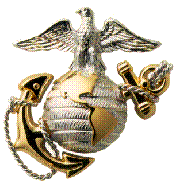 millet, fire, ax, and the symmetrical "fu" symbol.
millet, fire, ax, and the symmetrical "fu" symbol.
Emblem of the United States Marine Corps,
silver gilt.

Emblem of Rotary International, "an
organization of business and professional leaders united worldwide
who provide humanitarian service, encourage high ethical standards
in all vocations, and help build goodwill and peace in the world."
Emblem of the Hizballa, an organization of Islamic militants.
Emblem of Belarussia, a country formerly a part of the soviet Union.
emboss, embossment - To create a raised design or relief on a flat surface, usually of metal or paper, by pressing or hammering a design into the back side. Embossment is the result of having been embossed.
Example:

This is a sample of an embossed card
stock paper given a golden surface.

Abelardo Morell (American, born Cuba, 1948-), 1841 Book of Proverbs for the Blind, 1995, photograph of a book illuminated by a raking light which reveals that all lettering on the book's pages were embossed.
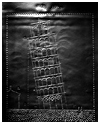
Abelardo Morell, Leaning Tower of Pisa Illustration for the Blind, 2000, photograph of a book illustration intended to be "seen" by a blind person. This picture and the Braille text which is part of it is comprised entirely of embossed dots.
Also see boss, leather, raising, relief, and repoussé.
embrasure - In architecture, a splayed opening in a wall that enframes a doorway or a window.
(pr. əm-BRAY-zhər)
emerald green - A particular green pigment.
Related resource:
emerging artist - A hopeful label to signify a recent art school graduate or an exhibiting school age artist.
Also see children's art and juvenilia.
emery - Coarse corundum used as a powder or paste for the abrasion and polish of stone or metal.
Also see grind.
emotionalism - An aesthetic and critical theory of art which places emphasis on the expressive qualities. According to this theory, the most important thing about a work of art is the vivid communication of moods, feelings, and ideas.
Also see audience, empathy, expressionism, formalism, imitationalism, kitsch, meaning, sentimentality, subject, and viewer.
empathy - Sympathy for another's situation, feelings, and motives. An imaginative projection of one's own feelings to an object or event.
Quotations about empathy:
Also see attitude, bias, effort, emotionalism, expression and expressionism, motivation, praise, and xenophilia.
emphasis - Any forcefulness that gives importance or dominance (weight) to some feature or features of an artwork; something singled out, stressed, or drawn attention to by means of contrast, anomaly, or counterpoint for aesthetic impact. A way of combining elements to stress the differences between those elements and to create one or more centers of interest in a work. Often, emphasized elements are used to direct and focus attention on the most important parts of a composition — its focal point. Emphasis is one of the principles of design. A design lacking emphasis may result in monotony.
Emphasis originated in the root of the Greek word emphainein, to exhibit or display.
Examples:

Gustav Klimt (Austrian, 1862-1918), Serena Lederer (died 1943), 1899, oil on canvas,
75 1/8 x 33 5/8 inches (190.8 x 85.4 cm), Metropolitan Museum
of Art, NY. The head in this portrait is emphsized by contrasting
its dark features to the whiteness everywhere else. See Austrian
art, portrait,
and secession.

Charles Demuth (American, 1883-1935), The Figure 5 in Gold, 1928, oil
on cardboard, 35 1/2 x 30
inches (90.2 x 76.2 cm), Metropolitan Museum of Art, NY. In the
1920's Demuth produced a series of poster-portraits honoring
his contemporaries, inspired by Gertrude Stein's word-portraits.
The Figure 5 in Gold is the most accomplished of the group.
It was dedicated to the artist's friend William Carlos Williams,
the American poet whose "The Great Figure" inspired
the painting's title and imagery. Demuth's painting, however,
is not a representational
illustration
of the poem but rather an abstract
impression of the No. 5 fire
engine clanging through the lamp-lit streets of the darkened,
rainy city. Scattered words and initials refer to the artist
and the poet. The number "5" is emphasized by repeating
it, by varying the thickness of the line with which it is drawn,
and by making its largest version so very large. See Futurism and text.

Robert Minor (American, 1884-1952), Pittsburgh,
1916, lithographic
crayon and India
ink, published in The Masses, no. 8, August 1916.
Robert Minor produced this drawing
as an editorial cartoon,
commenting on a 1916 steel workers' strike. He emphasized the
thrust of the soldier's bayonet by drawing its direction as the
counterpoint to that of the worker's body. The grace of this
juxtaposition results in our
feeling all the more shock at the sight of the pointed blade.
Minor drew inspiration for this approach from such European masters
as Francisco Goya and Honoré Daumier, coming to produce
such spare, forceful drawings as this. See movement, Realism, Romanticism, and social
realism.
Quote:
Also see accent, camouflage, compare, contrast, and juxtaposition.
empirical - Relying on or derived from observation or experiment. See empiricism.
empiricism - The philosophical stance that experience, especially of the senses, is the only source of knowledge. Also, the use of empirical methods.
Also see epistemology, interdisciplinary, metaphysics, ontology, phenomenology, and teleology.
empower - To enable, to invest with power, as in giving recognition to artists who are members of marginalized groups.
Also see multiculturalism, political correctness (PC), xenophilia, and xenophobia.
empty shape - In an artwork a shape that is left bare instead of filled with lines or color.
Also see closed shape, lacuna, negative space, and open shape.
emulation - Imitation; especially in order to equal or exceed a model. In computer terminology, it refers to a means to allowing software written for one computer platform to run on another.
Also see chinoiserie and derivative.
emulsifier - A catalyst combining oil, water and varnish into media for painting.
Also see solvent.
emulsify - To create an emulsion.
emulsion - A suspension of small globules of one liquid in a second liquid with which the first will not mix. A photosensitive (light sensitive) material which consists of a coating of silver halide grains in a gelatin layer, on photographic metal plates (for a daguerreotype), glass plates, film, fabric, paper, or other surfaces.
(pr. ə-MUL-shən)
Also see emulsifier, negative, photography, positive,
and stain.
https://inform.quest/_art